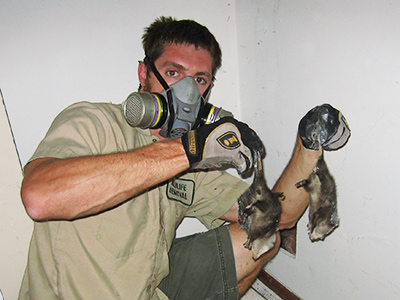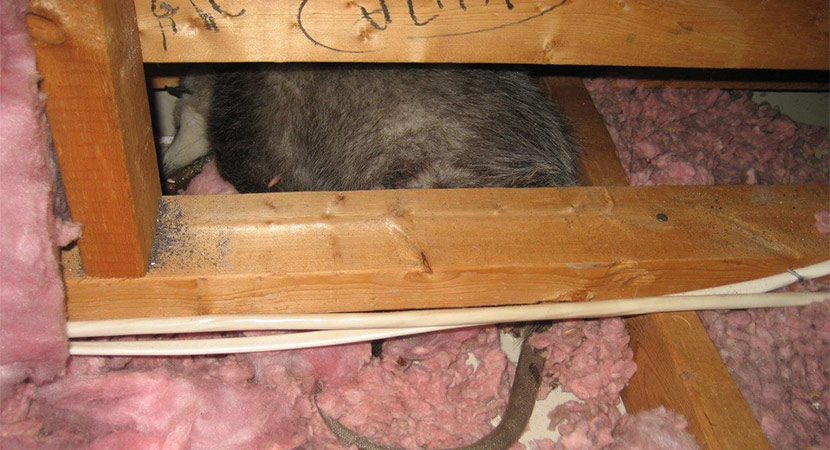Call me: 859-795-3327
Welcome to Lexington Dead Animal Removal! Got a terrible smell in your house, or do you see a dead critter on your property? We are an animal control company specializing in the removal of dead animals from your home, attic, basement, walls, yard, or any part of your property. You clearly don't want a dead animal in your house. Carcasses attract flies and give off terrible smells, not to mention the potential diseases rotting flesh can cause. Whenever we remove dead animals, we use 100% safe methods and make sure to disinfect your home and get rid of all traces of odor. Click here for Free Roadkill Removal and click here for Dead Pet Body Removal. For deceased wild animals in your home or property, call us anytime at 859-795-3327 to schedule an appointment for today! We come out fast! Some of the services we offer include:
- Dead Animal Removal
- Foul Odor Diagnosis
- Full Property Inspections
- House Damage Repairs
- Dead Body Location Services
- Proper Carcass Disposal
- Cleanup & Decontamination Services
- Deodorization Services
CALL US ANYTIME AT 859-795-3327

Finding a dead animal on your property can be an awful and terrible experience. The process of removing them will be messy, smelly, and dangerous if you don't have the help of the experts. We are a family-owned business that helps in the removal of the carcass of animals. With more than a decade of experience, we have the expertise and the skills to get the job done efficiently. We will act timely to reduce the inconveniences. Our people will work hard to provide our clients with the best possible service. We remain updated on the latest innovation and developments in this field. We will only use scientifically-proven and safe products. We will never put your life in peril. We can remove and dispose of all dead animals regardless of their size or their state of decomposition. Do not wait for the body to contaminate your property or attract flies, beetles, and other scavengers. You can be exposing yourself to the risk of contracting zoonotic diseases. We have designed a comprehensive service that will deal with all the matters associated with your problem. We will also decontaminate your property and incinerate the carcass to guarantee proper disposal. Learn more about our dead animal removal service; contact us today, and our customer service representative will walk you through the entire process.
What Prices Do We Charge?
Learn about dead animal removal costs - each situation is different!
What if you found roadkill or a dead animal such as a deer in a public place, and you want the city or Fayette County services to remove it for free? Click here for Free Fayette County Dead Animal Removal services. What if a farm animal like a horse, or your beloved pet dog or pet cat has died and you need the body taken away? Click here for Dead Pet Body Removal.
We are experts in dead animal removal, and take our job seriously. When removing dead animals, we do a COMPLETE job — not only do we remove the dead animal from your home or yard, we also decontaminate the area, deodorize it, and dispose of the animal or cremate it. If you aren't sure whether the stench in your house is due to a rotting carcass or another reason, we can sniff it out with our noses from our years of experience. We remove dead raccoons, dead opossums, dead skunks, dead squirrels, dead birds, even dead dogs and cats. We frequently remove dead rodents from inside walls, because poison kills rats and mice, who die in your house. We completely solve your dead animal problem by taking these steps:
- Sniff out the dead animal if it is somewhere in your home
- When necessary, for example if the animal is in a wall or under your house, cut a hole to remove the animal
- Remove the dead animal, safely and completely (and seal the hole if needed)
- Finish the job by decontaminating and deodorizing your home
- Properly dispose of the dead animal through incineration or other means
- Prevent it from happening again by finding out how they got in your house
Dead animal carcass removal is specialty work. Sometimes the job is simple, such as a dead opossum in the yard, in which case we can simply wear our gloves and respirator mask, bag the carcass, and take it away for incineration. Sometimes this is more complex, such as when the dead animal is under a home crawlspace, under a porch or deck or shed. Or if the animal is larger, such as a dog or a deer. The most complex cases are dead animals inside the house. The animal may have died inside the attic, or down in the walls, or the duct work, or any other part of the architecture. You may have a bad smell in your home, and you're not even sure what's causing it. We've removed not just dead animals, but rotting food, bad mold, etc. We specialize in locating the source of the smell, and we very commonly cut a hole in the ceiling or wall to remove the animal. We remove every bit of the carcass, mop up the juices, vacuum the maggots, spray it and wipe it down with disinfectant, cleaner, and we repair the hole we cut. In some cases we use ozone machines to neutralize odor.
Lexington Dead Animal Tip: How to Properly Dispose of a Dead Animal Carcass

As you probably know, a wildlife carcass is usually a breeding ground for lots of bacteria and germs. Consequently, it exposes you and your family to several health risks. That’s why it’s important to dispose of animal carcasses promptly. While there are many wildlife carcass disposal methods, the most appropriate for your case is mainly dependent on what’s acceptable according to your local wildlife disposal laws. In the post, we explore some of the most common disposal methods.
Burying
This is the oldest disposal method. It involves placing the carcass in a plastic bag and placing the bag in a box before burying the box underground. The difficulty with the method lies in choosing an appropriate burial site. As a rule of thumb, select a location that’s far from underground water sources. Also, avoid areas that are prone to flooding. But why is this important? Dead animals can easily contaminate water sources, which can be harmful to humans and animals that drink from them. Because of the risks associated with burying, many districts do not allow it.
Composting
This is the most common above-ground disposal method. Composting is a biological process in which microorganisms are left to consume organic materials, leaving behind a nutrient-rich end product, referred to as compost. Large carcasses are ideal for composting because of their high nitrogen content. Composting relies on naturally-occurring microbes, such as fungi and bacteria to break down the organic matter.
Composting is best suited for disposing of livestock like cows, horses, and pigs on the farm. The resulting compost can be used to boost soil quality.
Landfills
Some municipal landfills accept dead animal carcasses. However, they tend to be quite expensive. This is usually a good option because you’re handing over the carcass to professionals that are well equipped to deal with it.
With this option, all you need to do is bag the carcass so it can be transported to the landfill. Remember to confirm with your municipal landfill to be certain they accept wildlife carcass.
Burning
The burning of carcasses is also a disposal method used mainly in developing countries. The main challenge with burning is the difficulty in controlling the process. Furthermore, the temperature reached in burning is usually insufficient to kill all pathogens. Consequently, ash and wastes generated from the process can easily contaminate water bodies. Carcinogens are also released during burning, and they may affect human health if inhaled.
Incineration
This one of the most effective methods of dealing with wildlife carcasses. Incineration involves the burning of animal carcasses at high temperatures (>850 degrees C) into inorganic ash. This high temperature ensures the destruction of all infective agents. Furthermore, the ash resulting from incineration is only about 1 - 5% of the initial carcass volume. The main concern with incineration is the release of gaseous pollutants resulting from incomplete combustion. However, a well-designed incinerator can drastically reduce the risk of noxious emissions release. That’s why incinerators require permits before they can be operated. Furthermore, certain guidelines must be followed to limit air pollution. Although incineration is very effective, it is quite an expensive disposal method.
Rendering
This process involves the conversion of dead animal bodies to pathogen-free useful byproducts, such as a feed protein. In this process, the carcasses are exposed to moderately high temperatures (about 130 degrees C) using pressurized steam to kill most pathogens.
In general, rendering facilities are user- and eco-friendly. This makes them very effective for carcass disposal. Efficient rendering systems convert most of the biomass to saleable products while the unusable waste ends up in the landfill. Also, rendering is a cheaper alternative. For these reasons, rendering is usually considered the best option for dead animal disposal.
Wrap Up
Dead animals expose you to the risk of several diseases. That’s why they need to be disposed of properly and effectively. We’ve explored some of the most common disposal methods. Before you opt for any one of them, ensure you check with your local wildlife authority to ensure your preferred method is approved in your city.
We service nearby towns such as Lexington, Andover, Athens, Clays Ferry, Colby, Little Texas, South Elkhorn, Spears, Todds Station,.